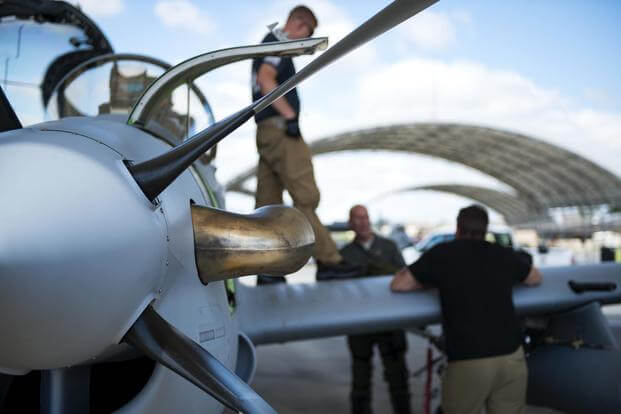While the U.S. Air Force hasn't closed the door to a possible light attack program, efforts to procure a new turboprop aircraft for training with allies appear to have lost steam as other priorities have come to the fore.
Service leaders in recent weeks said they're looking at the possibility of another light attack "experiment," one that could involve helicopters, drones and even participation by allies who already have light attack aircraft.
"What is the right mix of fixed-wing, rotary-wing, manned and unmanned [aircraft] that can do the business of light attack?" Chief of Staff Gen. David Goldfein told Defense News in a Jan. 26 interview. "What is the right mix and how do we bring allies and partners in right now with us -- not just periodically parachute in -- but how do we expand this experiment to bring them into the tent with us?"
Lt. Gen. Arnold Bunch, the Air Force's military deputy for the office of the Assistant Secretary of the Air Force for Acquisition, said the concept of light attack began as a way to support allies and partners, but was designed to fill other needs as well.
Related content:
- From Old Pilots to New Planes, Air Force Chief Talks 'New Ways of Doing Business'
- The Air Force's Light Attack Search Won't Yield a New A-10. Here's Why
- Space Force, F-15X, Light Attack: What Will the Air Force Seek in Latest Budget?
Bunch told audiences at an Air Force Association breakfast Feb. 1 that light attack was also intended to be an "additive mix" to the service's own force of fourth- and fifth-gen planes.
Goldfein in the past has described light attack as a "network approach" to help share intelligence between partners.
"It was additive. [Light attack] could not take the place of any of the other missions we have. It would be added on top," Bunch said.
But in line with the Pentagon's National Defense Strategy, other priorities have climbed up the Air Force's wish list for the next fiscal budget request, he said.
And there's a good chance the service's light attack plan will never become a reality.
"I have ideas of how we go forward, and I think I know how we go forward," Bunch said. "There will be more that will come out of this over time. We are planning to broaden the experimentation out and carry [that] forward, and I think when our budget hits, you'll understand more of what we're doing."
He said the Air Force needs to keep an open dialogue with companies, and be transparent about the fact that not every experiment will lead to an acquisition program.
"If we're really going to do this, it's going to take all of us working together," Bunch said, speaking broadly to any new programs the service is shopping around for. "Are all of them going to work out? We do experiments to experiment. Not everything is going to result going forward on programs. We learn. That's part of experimentation."
Should companies invest resources in Air Force experiments, then, if there's no guarantee of a payoff?
One expert suggests treading lightly.
"The contractors are totally right on this one. Why get burned?" said Richard Aboulafia, vice president and analyst at the Teal Group.
"If this was a smart program with a necessary requirement and a bright future, there's a lot to be said for investing in it. But it's more likely that this program falls somewhere between political messaging and temporary foolishness," Aboulafia told Military.com on Monday.
Congress thus far has been eager to see a plan. In November 2017, key lawmakers agreed to provide the Air Force $400 million to continue experimenting with the light attack concept. The Senate Armed Services Committee, in its fiscal 2019 proposal, then added $350 million to procure a future light attack aircraft.
The Air Force was supposed to publish a final request for proposal in December for a light attack aircraft, but it never happened.
The service first held a series of light attack experimental fly-offs and maneuvers at Holloman Air Force Base, New Mexico. The Air Force in 2016 announced plans to hold the flight demonstrations with a handful of aircraft to test whether lighter, less expensive off-the-shelf aircraft might be suitable for lower-risk missions in places such as Afghanistan.
The second phase of the experiment was canceled in July following a fatal crash.
But even with the second phase cut short, Air Force officials have said the best fits for light attack are the Textron Aviation AT-6 Wolverine and Sierra Nevada/Embraer A-29 Super Tucano.
Whether other turboprop aircraft will come back into the experiment has not been disclosed.
With so many hypotheticals, Aboulafia said the Air Force needs to be clear about its new path forward on light attack, especially if it wants to expand the enterprise with drone and helicopter makers.
Otherwise, its message may be lost. Aboulafia said he expected contractors to "vote with their feet," walking away from the light attack effort.
"The service will need to decide on the basis of off-the-shelf models and knowledge," he said. "But that doesn't matter, since this rather absurd requirement will likely be canceled anyway."
Bunch, however, said light attack has been a successful effort for the Air Force.
"I do believe it has been a success. I may be the only one that believes it, but I actually believe it has been a success," he said. "We tried something we hadn't done. We built a partnership with industry. We experimented. We learned a lot, and we got to the point where we weren't ready to make a large buy decision at this stage. I still believe that is learning."
-- Oriana Pawlyk can be reached at oriana.pawlyk@military.com. Follow her on Twitter at @Oriana0214.










